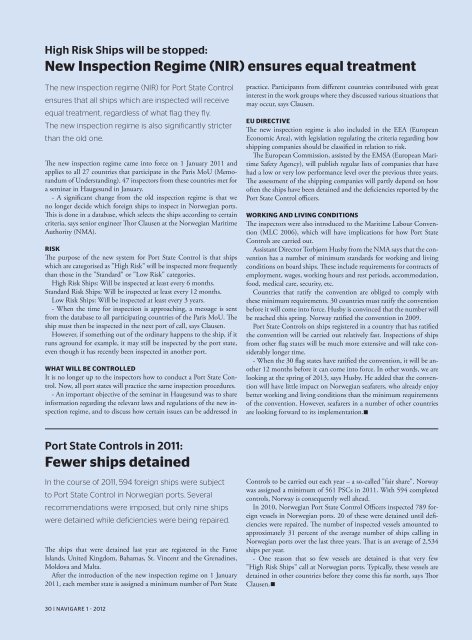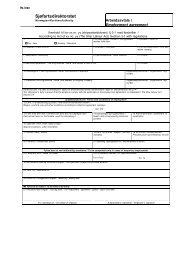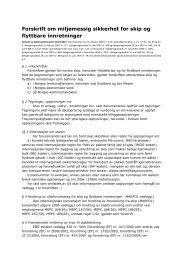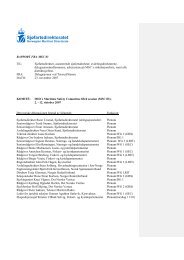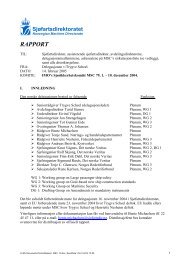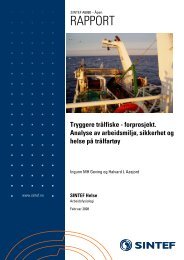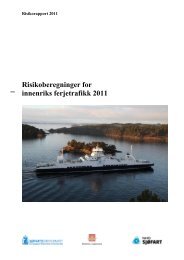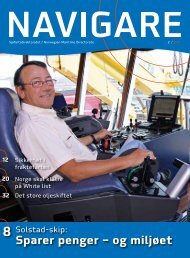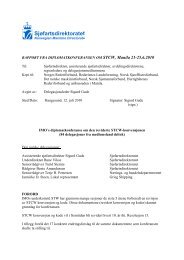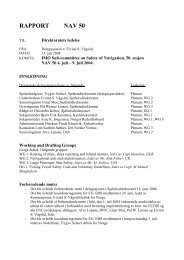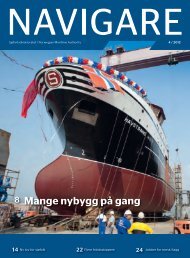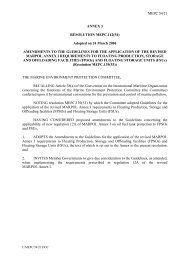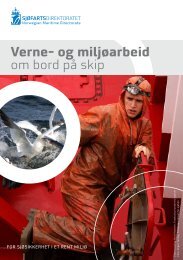Create successful ePaper yourself
Turn your PDF publications into a flip-book with our unique Google optimized e-Paper software.
High Risk Ships will be stopped:<br />
New Inspection Regime (NIR) ensures equal treatment<br />
The new inspection regime (NIR) for Port State Control<br />
ensures that all ships which are inspected will receive<br />
equal treatment, regardless of what flag they fly.<br />
The new inspection regime is also significantly stricter<br />
than the old one.<br />
The new inspection regime came into force on 1 January 2011 and<br />
applies to all 27 countries that participate in the Paris MoU (Memorandum<br />
of Understanding). 47 inspectors from these countries met for<br />
a seminar in Haugesund in January.<br />
- A significant change from the old inspection regime is that we<br />
no longer decide which foreign ships to inspect in Norwegian ports.<br />
This is done in a database, which selects the ships according to certain<br />
criteria, says senior engineer Thor Clausen at the Norwegian Maritime<br />
Authority (NMA).<br />
RISK<br />
The purpose of the new system for Port State Control is that ships<br />
which are categorised as "High Risk" will be inspected more frequently<br />
than those in the "Standard" or "Low Risk" categories.<br />
High Risk Ships: Will be inspected at least every 6 months.<br />
Standard Risk Ships: Will be inspected at least every 12 months.<br />
Low Risk Ships: Will be inspected at least every 3 years.<br />
- When the time for inspection is approaching, a message is sent<br />
from the database to all participating countries of the Paris MoU. The<br />
ship must then be inspected in the next port of call, says Clausen.<br />
However, if something out of the ordinary happens to the ship, if it<br />
runs aground for example, it may still be inspected by the port state,<br />
even though it has recently been inspected in another port.<br />
WHAT WILL BE CONTROLLED<br />
It is no longer up to the inspectors how to conduct a Port State Control.<br />
Now, all port states will practice the same inspection procedures.<br />
- An important objective of the seminar in Haugesund was to share<br />
information regarding the relevant laws and regulations of the new inspection<br />
regime, and to discuss how certain issues can be addressed in<br />
practice. Participants from different countries contributed with great<br />
interest in the work groups where they discussed various situations that<br />
may occur, says Clausen.<br />
EU DIRECTIVE<br />
The new inspection regime is also included in the EEA (European<br />
Economic Area), with legislation regulating the criteria regarding how<br />
shipping companies should be classified in relation to risk.<br />
The European Commission, assisted by the EMSA (European Maritime<br />
Safety Agency), will publish regular lists of companies that have<br />
had a low or very low performance level over the previous three years.<br />
The assessment of the shipping companies will partly depend on how<br />
often the ships have been detained and the deficiencies reported by the<br />
Port State Control officers.<br />
WORKING AND LIVING CONDITIONS<br />
The inspectors were also introduced to the Maritime Labour Convention<br />
(MLC 2006), which will have implications for how Port State<br />
Controls are carried out.<br />
Assistant Director Torbjørn Husby from the NMA says that the convention<br />
has a number of minimum standards for working and living<br />
conditions on board ships. These include requirements for contracts of<br />
employment, wages, working hours and rest periods, accommodation,<br />
food, medical care, security, etc.<br />
Countries that ratify the convention are obliged to comply with<br />
these minimum requirements. 30 countries must ratify the convention<br />
before it will come into force. Husby is convinced that the number will<br />
be reached this spring. Norway ratified the convention in 2009.<br />
Port State Controls on ships registered in a country that has ratified<br />
the convention will be carried out relatively fast. Inspections of ships<br />
from other flag states will be much more extensive and will take considerably<br />
longer time.<br />
- When the 30 flag states have ratified the convention, it will be another<br />
12 months before it can come into force. In other words, we are<br />
looking at the spring of 2013, says Husby. He added that the convention<br />
will have little impact on Norwegian seafarers, who already enjoy<br />
better working and living conditions than the minimum requirements<br />
of the convention. However, seafarers in a number of other countries<br />
are looking forward to its implementation.<br />
Port State Controls in 2011:<br />
Fewer ships detained<br />
In the course of 2011, 594 foreign ships were subject<br />
to Port State Control in Norwegian ports. Several<br />
recommendations were imposed, but only nine ships<br />
were detained while deficiencies were being repaired.<br />
The ships that were detained last year are registered in the Faroe<br />
Islands, United Kingdom, Bahamas, St. Vincent and the Grenadines,<br />
Moldova and Malta.<br />
After the introduction of the new inspection regime on 1 January<br />
2011, each member state is assigned a minimum number of Port State<br />
Controls to be carried out each year – a so-called "fair share". Norway<br />
was assigned a minimum of 561 PSCs in 2011. With 594 completed<br />
controls, Norway is consequently well ahead.<br />
In 2010, Norwegian Port State Control Officers inspected 789 foreign<br />
vessels in Norwegian ports. 20 of these were detained until deficiencies<br />
were repaired. The number of inspected vessels amounted to<br />
approximately 31 percent of the average number of ships calling in<br />
Norwegian ports over the last three years. That is an average of 2,534<br />
ships per year.<br />
- One reason that so few vessels are detained is that very few<br />
"High Risk Ships" call at Norwegian ports. Typically, these vessels are<br />
detained in other countries before they come this far north, says Thor<br />
Clausen.<br />
30 | <strong>Navigare</strong> 1 - 2012


